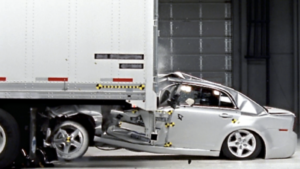What are the most dangerous highways? Each year, about 500 fatal collisions, some with more than one victim, occur on the highways of Washington state.
These collisions aren’t spread evenly throughout the state, however. Many serious crashes take place on just a handful of roads and highways.
Below, learn more about seven of the most dangerous highways in Washington State, what makes them so treacherous, and some steps you can take to reduce your risk of being involved in a crash.
Interstate 5
I-5 runs across some of the most scenic parts of Washington, connecting British Columbia, Canada to Oregon and looking upon mountain passes and deep evergreen forests along the way. While some of Washington’s deadliest roads are made that way due to their isolation and the time it can take for help to arrive, traffic-packed I-5 isn’t one of them.
Hundreds of thousands of vehicles travel down I-5 each day, many at high speeds; inattention, speed, and heavy traffic can combine to create a dangerous pile-up collision. With 160 fatal crashes per year—and a full third of them involving alcohol—it’s prudent for drivers to use caution whenever traveling on I-5.
However, some parts of this interstate are riskier than others. Three of the ten most dangerous parts of Washington highways are on I-5:
- Exit 127 to 133
- This heavy commuter corridor is home to both morning and evening crashes, many of them serious.
- Exit 137 to 142A
- Another five-mile portion of interstate just outside Tacoma recently had five deadly accidents in a two-year period.
- Exit 14 to 16
- With an average of 1.4 fatal crashes per mile per year, this part of I-5 in northern Washington (just south of La Center) poses some geographic complications for distracted and impaired drivers.
The most dangerous portions of I-5 are largely concentrated around Tacoma and Seattle, and traffic experts largely attribute the fatal crash rate to the sheer volume of vehicles that travel it regularly.
State Route 99
Just shy of 50 miles long, State Route 99 (the Pacific Highway) has an annual average fatal crash rate of one every three miles. Much of this high crash rate can be attributed to the highway’s location, just outside Seattle, and the amount of traffic it sees each day.
The three deadliest stretches of State Road 99 include:
- Aurora Avenue between North Winona Avenue and North 155th Street
- This stretch of State Road 99 significantly increases the crash rate average with 2.2 deadly crashes per mile.
- South 252nd Street and South 176th Street
- Number two on the list, this stretch between Seatac and Des Moines averaged 1.8 deadly crashes per mile from 2017 to 2019.
- South 16th Avenue and South 263rd Street
- The third deadliest stretch of the Pacific Highway is between Federal Way and Kent. This part of the highway averages 1.2 deadly crashes per mile in recent years.
Washington has one of the highest rates of distracted driving in the U.S., and drivers who are on their phones, looking at the scenery, or engaged in some activity that’s taking their attention away from the road can be at risk of colliding with others. Adding high speed to the equation can be a disaster, as it’s harder to stop quickly or react to avoid an accident.
Highway 2
U.S. Highway 2 is dangerous for a different reason; it’s an incredibly rugged and remote roadway that can pose a danger for drivers traveling alone. If you’re involved in a single-vehicle accident on Highway 2 between Spokane and Seattle and can’t call for help on your own, it could be some time before someone finds you. And even if you can call for help, it can take an hour or more for emergency personnel to make it to you. Over the last 15 years, more than 60 people have died in car accidents on U.S. Highway 2, and the Washington State Department of Transportation has begun to implement measures to make this highway safer.
Hart’s Pass
This road, the highest road in Washington State, is more than a mile above sea level and leads to Slate Peak Lookout. Traveling through the Okanogan-Wenatchee National Forest, Hart’s Pass is a major tourist attraction that offers one-of-a-kind views of Washington’s most scenic mountains and forests. Due to the topography of the road and the climate in the area, Hart’s Pass is generally only open from July to October.
Unfortunately, these views come at a cost. This one-lane road can only accommodate small passenger vehicles. It’s largely unpaved, covered with dirt and gravel in various spots, and has no guardrails to shield you from the cliff faces below; a crash can leave you stranded without much ability to summon help. And even if the police or EMS are contacted, retrieving an injured driver or passenger from Hart’s Pass can be treacherous in itself.
To put it plainly, Hart’s Pass is about the last place you’d like to get into a car accident, making it one of Washington’s most dangerous highways.
State Road 167
The Tacoma Junction to N.W. 11th stretch of this state highway averages 1.2 fatal crashes per mile, largely due to the sheer amount of traffic between Tacoma and Puyallup. Other stretches of State Road 167 are less dangerous, but drivers should use extra caution in congested areas.
State Road 181
Like I-5, State Road 181 is a heavily-traversed highway in King County. This state road connects Tukwila and Kent, and the span from Meeker Street and South 180th Street averages 1.3 fatal crashes per mile per year due to traffic congestion, driver inattention, and drivers operating while intoxicated.
State Road 516
Between State Road 167 and South Military Road in the Kent area, this stretch of SR 516 conveniently connects travelers from 167 to I-6. But with 2.6 fatal crashes per mile on average, this short stretch can pose some dire risks for drivers. Like most of Washington’s most dangerous highways, SR 516 is in King County.
Protecting Yourself on Washington’s Highways
Most serious Washington traffic accidents come down to just a few factors: driver distraction, driver intoxication, and poor road or weather conditions. A full 33 percent of deadly crashes involved at least one intoxicated driver, while 31 percent of serious accidents are attributed to excess speed. And when driving like distracted—a factor in a full one of every four accidents—you’re even less equipped to respond to another driver’s negligence.
A few things you can do to improve your safety on Washington highways include:
- Avoid using your cell phone. Use a hands-free device if necessary—it’s the law!
- Be extra cautious when driving late at night or in congested areas. You may be more likely to encounter an impaired or distracted driver.
- Don’t ever drive after drinking or taking medication that may make you drowsy.
- Keep your cell phone fully charged or bring a charger with you if you’re planning to travel in a remote area (like Hart’s Pass). Have an emergency first-aid kit on hand, as well as road flares that can serve as a warning signal to other drivers traveling your way.
What to Do If You’re Involved in an Accident
If you’re involved in an accident in Washington State, the first—and most important—step is to get all involved to safety (if possible) and seek medical treatment for any injuries. Not all crash-related injuries are immediately apparent, and some (like whiplash or other soft tissue injuries) may take days or even weeks to appear. Get any new (or worsened) medical issues checked out as soon as you can.
You may also want to consult with an attorney. Insurance companies are motivated to settle claims, and when you’re facing hefty medical bills or lost wages, it can be tempting to accept a low-ball settlement offer. But this might not be in your best interest. An attorney can help you fight for all the funds you’re entitled to and ensure that you’re compensated for the pain you’ve suffered. Contact us today to schedule a consultation.



